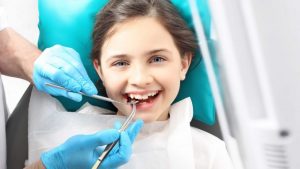From birth to teething first baby tooth
As a rule, the first tooth erupts in a child at 6 – 8 months. Until this time, wipes or cotton pads should be used to care for his oral cavity. To prevent the development of candidiasis (thrush) once or twice a week, it is recommended to wipe the child’s oral cavity with a cloth moistened with a weak solution of sodium bicarbonate (baking soda).
Teeth from 6 months to 3 years
The first incisors in the mouth are incisors (front teeth) on the lower and upper jaw. To clean milk teeth up to 1 year, you can use special sticks or gauze napkins. It is important to remember that a single tooth needs the same thorough care as 32. From 1 year, you can start using a toothbrush to care for your child’s oral cavity. At the same time, the bristles should be very, very soft, and the working head is very small. In the morning and evening you need to carefully clean each tooth of the baby from all sides. Toothpaste for very young children should be made in the form of a gel, that is, contain a minimum amount of abrasive (cleaning) substances and not contain fluoride at all. The fact is that fluorine is useful for teeth, but at such an early age an overdose can occur, which will have a devastating effect on the teeth. After all, it is difficult to control how much paste the baby swallows during the hygiene procedure. Children under 3 years of age may accidentally swallow 30% to 60% of toothpaste.
The sooner a child gets used to a toothbrush and toothpaste, the better. An example will be his parents, who themselves conscientiously look after their teeth. The first time you should brush your baby’s teeth. Do this in front of the mirror, showing how to hold the brush. By 3 years, the baby should master the basic movements with a brush.
First of all, teach your child to move the toothbrush from the gums to the edge of the tooth. In this case, the brush should turn slightly, as if sweeping, first the front surface of the tooth – “breast”, and then the back – “back”. To clean the chewing surfaces of the posterior teeth, you must ask the child to open his mouth wide, put a brush on the surface he chews, and move it from the edge of the jaw to the middle from left to right and from right to left, as if sweeping away the remnants of food and “evil” germs from the teeth. The child quickly gets used to this procedure if he performs it with you and if elements of the game are embedded in it. Therefore, rehearse teeth brushing on toys, come up with fairy tales whose characters always look after their teeth. Swap roles with your baby: let him brush your teeth himself. First you need to teach the child to brush his teeth without toothpaste, and immediately show the toothpaste to him and explain why it is needed. After your child gets used to the toothbrush, include toothpaste in the hygiene game. By the age of 3, the baby should brush his teeth on his own in the morning after breakfast and in the evening before bedtime. But even if a child in 2 – 3 years old completely independently copes with brushing his teeth, he should do this under the supervision of adults. When teaching a child oral care, remember how important is the personal example of parents and loved ones. Do not forget that in addition to brushing your teeth in the morning and evening, the child should rinse his mouth with boiled water after each meal.
Teeth of a child from 3 years to 5 years
By this age, the baby’s teeth erupted completely and a temporary bite formed. Toothpastes with special mineralizing additives and low second content, toothbrushes with soft bristles, mouthwashes without alcohol are reliable helpers and friends of children’s teeth aged 2 to 5 years.
Teeth of a child from 5 to 12 years old
This period is one of the most important in the formation of the whole organism in general and the dentofacial system in particular. The fact is that at 5 – 7 years old the first permanent tooth erupts. This is the first molar (the so-called 6th tooth). There are only four of them: two on each jaw, left and right. They are located immediately behind the baby teeth and are the main teeth that form the bite. Remember, these teeth are permanent and there will be no replacement!
Almost simultaneously with the appearance of the first molars, the change of milk (temporary) teeth to permanent begins. So, the first incisors erupt at the age of 6 – 8 years, the second incisors – 7 – 9 years, premolars – 10 – 12 years, fangs and second molars – 12 – 13 years. Immediately after their appearance, the process of maturation of enamel begins. It is as if it absorbs the necessary minerals from saliva, which make it strong and solid. During this period, you must definitely keep your teeth clean so that plaque does not interfere with the penetration of beneficial substances into the enamel.
A particularly effective weapon in the fight against caries at this age are toothpastes with fluoride, which:
- – prevent tooth damage and are even able to restore enamel in the initial stages of its destruction;
- – inhibit the metabolism of bacteria, thereby weakening their ability to form acids that destroy tooth enamel;
- – slow down the formation and spread of plaque.
Circular Fones Method.
With this method, the vestibular surfaces of the teeth are cleaned in a closed state. The brush field is placed in the right corner on the upper or lower vestibular surfaces of the teeth, cleansing is carried out in circular movements, excluding the marginal part of the gums. When opening the mouth, the oral surfaces are cleaned with small rotational movements. Horizontal or rotational movements clean the occlusal surfaces of the teeth. This method is indicated for children and adults. Leonard Method A toothbrush is installed perpendicular to the surface of the teeth, vertical movements are made only in the direction from the gum to the crown of the tooth: from the top to the bottom – from the top to the bottom of the jaw. The vestibular surfaces of the teeth are cleaned with closed jaws, the chewing surfaces are cleaned by moving the brush forward and backward. This method is known as the red to white gum to tooth method.
Bass Method The head of the toothbrush is positioned at an angle of 45 ° to the axis of the tooth. The ends of the fibers are pressed against the enamel and the papillae. In this position, vibrating movements with a small amplitude are produced. The fibers penetrate the interdental spaces and gingival groove, thereby contributing to good plaque removal. Bas’s method is not entirely simple. Incorrect position of the toothbrush, for example, vertically to the axis of the tooth, leads to damage to the epithelial attachment and gums. This method is indicated for adults.
Charters Method.
The head of the toothbrush is set at an angle of 45 ° to the axis of the tooth so that the ends of the fibers, touching the outer surface of the crown, reach the cutting edges. Gently pushing the tips of the bristles gently push into the interdental spaces. In this position, vibrating movements are performed. The fibers come in contact with the marginal gum and massage.
Stillman Method
With this technique, the bristles of the toothbrush are set at an angle of 45 ° in the direction of the roots of the teeth, followed by the rotation of the brush in the direction of the crowns. In this case, the bristles under pressure clean the interdental spaces. In the frontal area of the oral cavity, the toothbrush is mounted vertically, and the brushing technique is repeated. In the area of each tooth, these movements are recommended to be repeated 4-5 times.
Modified Stillman method.
The toothbrush is installed parallel to the axis of the dentition, while the bristles cover the crown of the teeth and mucosa. The bristles are pressed against the dentition in the area of the mucosa, and then the brush rises to the level of the masticatory surface with small vibrating movements. The standard method of brushing Pakhomova G.N. The dentition is divided into several segments. Tooth brushing begins with a site in the area of the upper right chewing teeth, successively moving from segment to segment. In the same manner, brush the teeth on the lower jaw.
When cleaning the vestibular and oral surfaces of molars and premolars, the working part of the toothbrush is placed at an angle of 45 ° to the tooth and cleaning movements are made from the gum to the tooth, while removing plaque from the teeth and gums. The chewing surfaces of the teeth are cleaned with horizontal (reciprocating) movements so that the fibers of the brush penetrate deep into the fissures and interdental spaces. The vestibular surface of the frontal group of teeth of the upper and lower jaws is cleaned with the same movements as molars and premolars. When cleaning the oral surface, the brush handle is placed perpendicular to the occlusal plane of the teeth, while the fibers are at an acute angle to them and capture not only the teeth, but also the gum.
Click Here: https://versaillesdentalclinic.com/
 Bloggers Trend Keeping You Up To Date
Bloggers Trend Keeping You Up To Date



